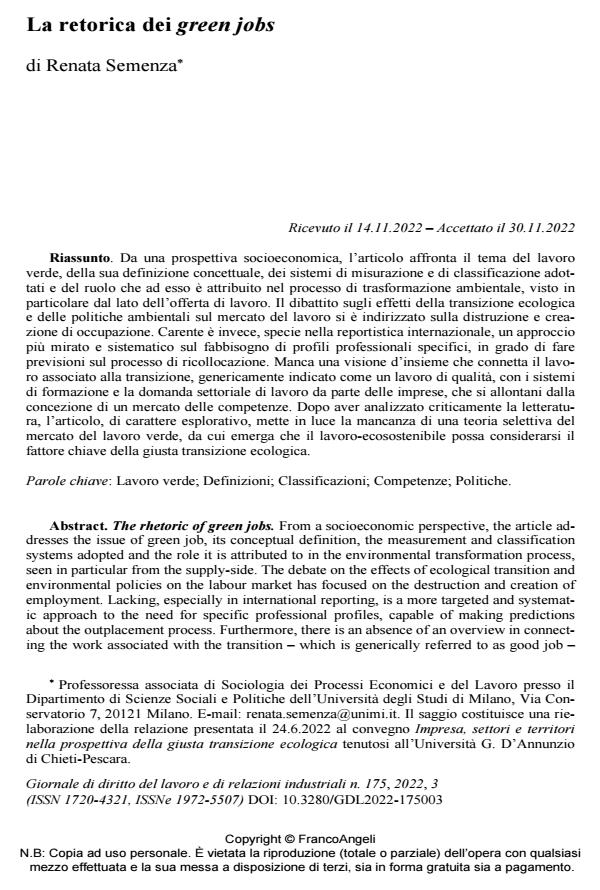The rhetoric of green jobs
Journal title GIORNALE DI DIRITTO DEL LAVORO E DI RELAZIONI INDUSTRIALI
Author/s Renata Semenza
Publishing Year 2023 Issue 2022/175
Language Italian Pages 17 P. 359-375 File size 232 KB
DOI 10.3280/GDL2022-175003
DOI is like a bar code for intellectual property: to have more infomation
click here
Below, you can see the article first page
If you want to buy this article in PDF format, you can do it, following the instructions to buy download credits

FrancoAngeli is member of Publishers International Linking Association, Inc (PILA), a not-for-profit association which run the CrossRef service enabling links to and from online scholarly content.
From a socioeconomic perspective, the article addresses the issue of green job, its conceptual definition, the measurement and classification systems adopted and the role it is attributed to in the environmental transformation process, seen in particular from the supply-side. The debate on the effects of ecological transition and environmental policies on the labour market has focused on the destruction and creation of employment. Lacking, especially in international re-porting, is a more targeted and systematic approach to the need for specific professional pro-files, capable of making predictions about the outplacement process. Furthermore, there is an absence of an overview in connecting the work associated with the transition - which is generically referred to as good job - with the training systems and the sectoral demand for work by companies, which moves away from the conception of a skills market. After having critically analysed the literature, what the article, of an exploratory nature, highlights is the lack of a se-lective theory of the green labour market, from which it emerges that eco-sustainable work can be considered the key factor of the just ecological transition.
Keywords: Green Job; Definitions; Classifications; Skills; Policies.
- Impresa e transizione ecologica: alcuni profili lavoristici Valerio Speziale, in GIORNALE DI DIRITTO DEL LAVORO E DI RELAZIONI INDUSTRIALI 179/2023 pp.283
DOI: 10.3280/GDL2023-179001 - Ecological and digital transition: "Travelling" in parallel for an everlasting future more sustainable Victor Meseguer-Sanchez, Isabel Martínez-Alcalá, Paola De Santis, in RIVISTA DI STUDI SULLA SOSTENIBILITA' 2/2024 pp.49
DOI: 10.3280/RISS2024-002004 - Transizione ecologica e politiche del mercato del lavoro Riccardo Salomone, in GIORNALE DI DIRITTO DEL LAVORO E DI RELAZIONI INDUSTRIALI 177/2023 pp.29
DOI: 10.3280/GDL2023-177004 - Trasformazioni, valori e regole del lavoro Lara Lazzeroni, pp.735 (ISBN:979-12-215-0507-8)
- Responsabilità sociale d'impresa 2.0 e sostenibilità digitale Lara Lazzeroni, (ISBN:979-12-215-0262-6)
- La giusta transizione tra questione sociale e questione ambientale: il potenziale ecologico delle mobilitazioni operaie Emanuele Leonardi, in GIORNALE DI DIRITTO DEL LAVORO E DI RELAZIONI INDUSTRIALI 177/2023 pp.99
DOI: 10.3280/GDL2023-177007 - Ricordo di Riccardo Del Punta Roberto Romei, in GIORNALE DI DIRITTO DEL LAVORO E DI RELAZIONI INDUSTRIALI 177/2023 pp.23
DOI: 10.3280/GDL2023-177003
Renata Semenza, La retorica dei green jobs in "GIORNALE DI DIRITTO DEL LAVORO E DI RELAZIONI INDUSTRIALI " 175/2022, pp 359-375, DOI: 10.3280/GDL2022-175003